Battle Ropes are a versatile tool that you often only see used for Wave Exercises. And while Wave Exercises with the Battle Ropes are a great way to improve your strength and conditioning so are Rope Pulling Exercises.
Rope Pulls are a great functional exercise to strengthen your arms, back, core and legs while getting your heart rate up to improve your conditioning.
If you want strength and endurance, you need to include Battle Rope Pulls in your workout routine.
Using the Battle Ropes – Battle Ropes Pulls
Just like with the Battle Ropes Wave Exercises, you can target different muscles with the Rope Pulls by changing your position as you do the move. Some of the Rope Pulls are done standing while others are done half kneeling or even seated. Some of the best Rope Pulls for your core and glutes are even done in the Plank position.
When you do rope pulls, you can control the intensity of the move by how many times you wrap the rope around the pole or pulling station. The more times you wrap the rope around, the harder it will be to pull.
As you do these moves, you may find that at points the rope gets stuck. This is part of the challenge and a part of what makes the move so functional. However, if the rope gets so stuck you can’t budge it, don’t be afraid to reach up and adjust.
Here are 10 different Battle Ropes Pulling Exercises.
Standing Pull Down – A great Rope Pulling Exercise to start with is the Standing Pull Down. This move is easier although it can be made more challenging by wrapping the rope around more times.
The Battle Ropes Standing Pull Down really work your arms, lats and core. You may even use your legs to help you pull if the rope is really wrapped to challenge you.
To do the Standing Pull Down, wrap the rope around a pole or pulling station up above your head. Wrap it around enough times that you have to work to pull and the rope doesn’t just easily flow through.
Then standing with your feet between hip-width and shoulder-width apart, sink into a very high squat, pushing your butt back while keeping your chest up. Reach up and grab the rope with one hand above your head.
Pull down on the rope, driving your elbow down and even a little bit back. As you pull down with one hand, reach the other hand up overhead to grab the rope and pull down.
Keep alternating arms to pull the rope down. Do not pull with both hands at the same time. Alternate pulls with each arm.
Make sure to complete a full range of motion and drive the elbow down and back as you pull. Do not round forward as you pull the rope. Use your back and keep your chest up nice and tall.
Make sure to engage your abs to protect your low back. You may use your legs a bit to pull, but do not pull with both hands at once!
Standing Chest Pulls – Another great basic Rope Pull is the Standing Chest Pull. This move is easier than any of the half-kneeling, seated or plank pulls because you are able to use your legs if you struggle to pull.
The Standing Chest Pull is also a variation of the traditional Back Row, which means it is a great move to strengthen your grip, biceps and back.
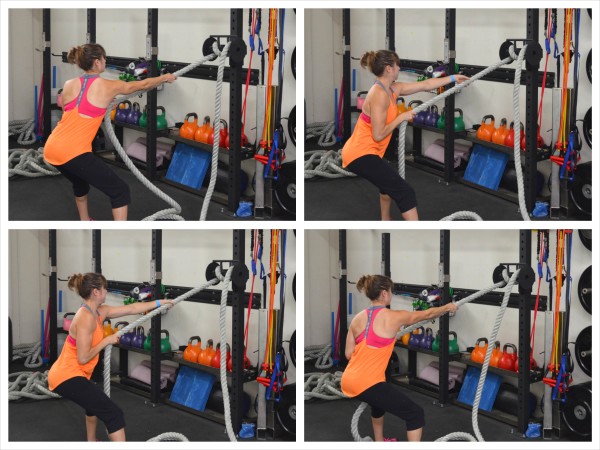
To do the Standing Chest Pull, place the rope pulling station or anchor at about chest height. A little higher or lower is fine. Wrap the rope around the anchor and sink into a high squat, pushing your butt back while keeping your chest up.
Reach one hand out in front of you and grab the rope. Keeping your chest pressed out and shoulders relaxed (aka no shrugging), pull the rope to you. Drive your elbow down and back as you pull.
Feel your back working to pull the rope and make sure you don’t turn this into a bicep curl.
As you pull the rope to your chest, reach your other hand out and grab the rope. Pull the rope toward you with the other hand.
Keep alternating sides and pulls. Do not use both hands at the same time to pull.
You can do this move with no rotation and really focus on your back and biceps or you can get your core and legs a bit more involved. You will definitely want to get your core and legs involved if you struggle to pull the rope.
To use your core and legs, make sure to sit your butt back. And then as you pull. shift your weight from side to side rotating just a little as you pull. As you reach to pull, you will shift your weight toward that side to reach a bit further. And then as you pull the rope back toward you, you will shift your weight away, pushing your glutes back and rotating open a bit toward the rope.
This will load the other side so your weight is shifted toward the side reaching next.
By shifting and rotating a bit, you will use your core and legs to help power the pull and not just your back. This is especially helpful when you are doing a circuit where the sled has to be heavy enough for your legs, but may be too heavy for your back and biceps alone. This will allow your legs and core to assist your upper body in pulling. For a sled circuit using this pull, check out our Full-Body Sled Workout.
Standing Lateral Pulls – With this move you can really work your core and isolate each arm and the sides of your back so that your dominate side can’t take over and pull more. This move may be a bit confusing to start since you are only pulling with the outside hand and your inside arm may want to try to help.
This can also be a tougher move since you are only using one arm and pulling laterally so make sure to adjust the wrap accordingly.
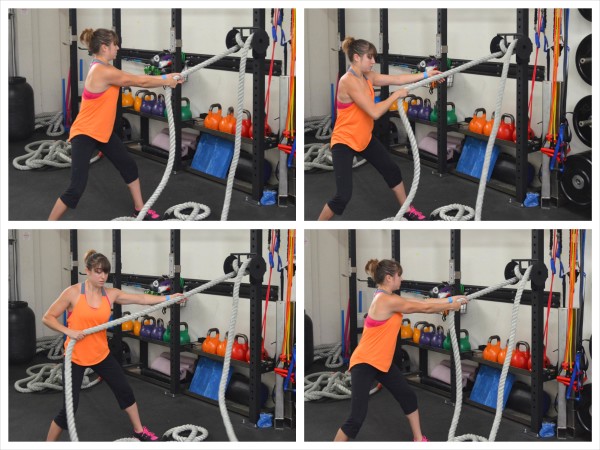
To do Standing Lateral Pulls, wrap the rope at about chest height. Stand with one side to the anchor point, facing the rope. Sink into a high squat and reach your inside arm (arm closest to the anchor point) toward the anchor point to grab the rope.
Hold the rope loosely with that inside arm.
Then reach your outside arm across your body to grab the rope right inside your other hand.
Pull the rope across your body with that outside arm, driving your elbow down and out to the side. Make sure that you don’t shrug your shoulders as you pull and that you feel your back powering the pull. Do not let your back round as you pull.
You can also pivot that back foot to use your legs a bit more to help with the pull.
Once you complete the time, length or number of pulls, switch to the other side and pull again with the outside arm.
Standing Hip Hinge Pulls – This is a great move to work your arms, shoulders, back and glutes; however, you must be careful to not load your low back as you do this.
If you are finding you feel this move in your low back, you may want to stick with another standing variation or try the Reverse Plank Pulls instead.

To do the Standing Hip Hinge Pull, wrap the rope down low and step over it so that the rope is between your feet and you are facing away from the anchor point.
Hinge over, pushing your butt back and bending your knees slightly as you reach back between your legs to grab the rope. Keep your back flat as you reach through to get the rope. Do not round forward.
Pull the rope forward as you drive through your heels and come back up to standing. Keep your core engaged as you pull and use your hips to drive the movement.
Squeeze your glutes at the top.
Then hinge back over, pushing your butt back as you reach through your legs to grab the rope with the other hand.
Again stand up and pull the rope through, powering the move with your glutes.
Keep alternating pulls.
Make sure to keep your core engaged and sit your butt back so that you load your glutes and hamstrings and not your low back. Also do not round forward as you hinge over.
Half-Kneeling Pulls – Not only can you change up Rope Pulls by doing them facing different directions and with the rope wrapped at different heights, but you can also change them up by doing the half-kneeling. Half-kneeling forces your glutes and core to work hard to stabilize while talking your legs out of the equation.
Half-kneeling does not allow you to use your legs to pull and forces your core to work very hard to stabilize as your back and biceps pull the rope.
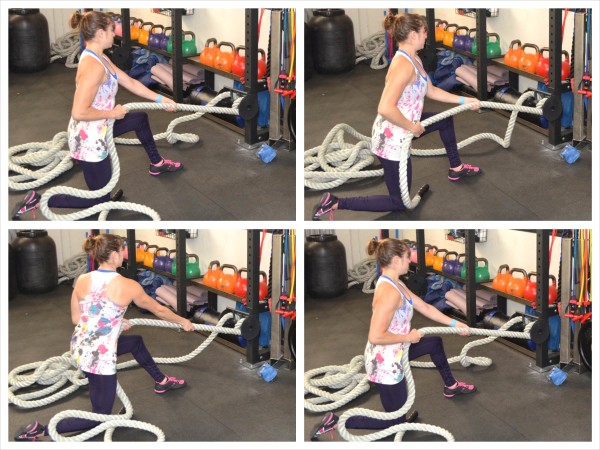
To do the Half-Kneeling Pulls, set up in the half-kneeling position with one knee bent to 90 degrees in front of you and your foot flat on the ground while your other knee is down on the ground with your leg behind you.
Your chest should be up nice and tall as you half kneel with the rope in front of you.
Reach the arm opposite the front leg out toward the rope wrapped in front of you. Grab the rope, and keeping your chest up nice and tall and glutes engaged, pull the rope toward you.
Drive your elbow down and back as you pull and make sure not to shrug your shoulders. As you pull the rope all the way back, reach forward with your other hand to grab the rope and pull it back with the other side.
Feel your back working to pull the rope. Your core and glutes should also be engaged to help you maintain a nice tall posture. Alternate pulls.
Do not pull the rope with both hands at once.
Also make sure that you do not round forward as you pull.
Make sure to half kneel on both sides.
For a variation of this move, you can also only pull with the arm opposite the leg forward and use the other hand to hold the rope up like you do with the lateral pulls.
Half-Kneeling Lateral Pulls – Half-Kneeling Lateral Pulls are a great way to change up the Standing Lateral Pulls. They force your core and glutes to work hard to keep you balanced while not allowing you to use your legs to help pull like with the Standing variation.
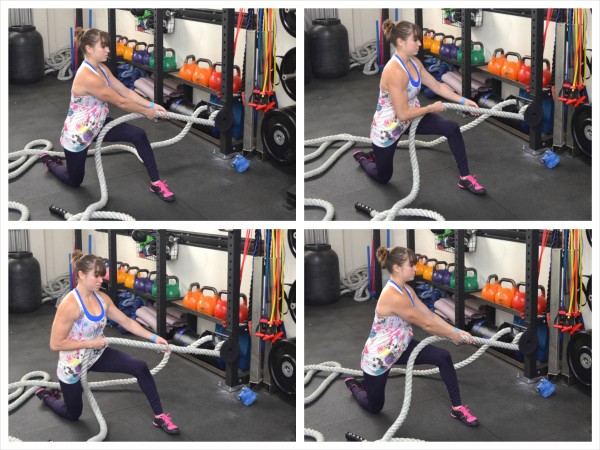
To do the Half-Kneeling Lateral Pulls, start half kneeling with your side to the anchor point and the knee closest to the anchor point up. Your chest should be up nice and tall. Reach your hand closest to the anchor point out to grab the rope and hold the rope loosely.
Then reach your outside hand across your body to grab the rope right inside your other hand. Keeping your chest up nice and tall and your glutes and abs engaged, pull the rope across your body. Drive your elbow down and out as you pull.
Do not round forward or shrug your shoulders as you pull.
Stay up nice and tall.
After pulling the rope across your body, reach the outside hand back across to grab and pull the rope again.
Complete pulls on one side before half kneeling the other way and pulling with the other hand.
Seated Shoulder Pulls – Seated Shoulders Pulls are a great Rope Pulling Exercise to work your arms, shoulders and core.

To do Seated Shoulder Pulls, sit on the ground facing where the rope is wrapped with your legs stretched out in front of you. You can slightly bend your knees and place your feet flat on the ground.
Grab the rope and place the end over your shoulder and sit up nice and tall.
Reach toward the anchor point with one hand and pull the rope back over your shoulder. Do not round forward or shrug your shoulders as you pull. Also, do not let your elbow flare way up by your ears as you pull.
After pulling back with one arm, reach the other hand forward and pull the rope over your shoulder using that side.
Keep alternating pulls over that shoulder and then switch and pull over the other shoulder.
Make sure you don’t round forward as you pull.
Lateral Plank Pulls – Plank Pulls are a great way to work your core, aka everything from your shoulders to your knees, while also really strengthening your upper body.
Lateral Plank Pulls are an anti-rotational exercise you can use to strengthen your arms, back, core, shoulders, glutes and quads.
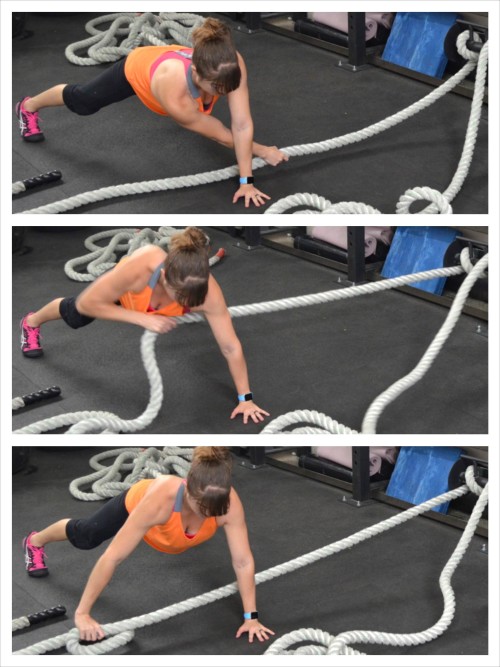
To do Lateral Plank Pulls, set up in a plank position with your hands under your shoulders and your feet between hip-width and shoulder-width apart. The wider apart your feet are, the more stability you will have.
Set up in this plank position so that the rope is across your chest and your side is to the anchor point.
Reach your outside arm under and across your body to grab the rope. Make sure that as you reach, you keep your core engaged so your hips stay level and you maintain the nice plank position.
Pull the rope across your body, making sure your hips don’t rotate as you pull. Pull the rope as far across as you can and then reach back across and pull again.
Do not shrug your shoulders as you pull and feel your back working to pull the rope across.
Also, do not let your hips sag or rotate or your butt go up in the air.
Complete all pulls on one side before switching and pulling across your body with the other arm.
Front Plank Pulls – Front Plank Pulls are another great core exercise to work your back and arms while developing core stability.
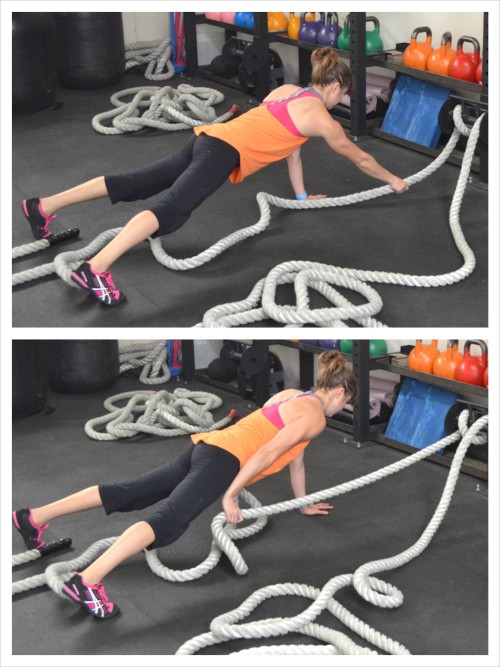
To do Front Plank Pulls, set up in a plank position with your hands under your shoulders and your feet between hip-width and shoulder-width apart. The wider apart your feet are, the easier it will be to keep your hips stabile and core engaged.
Set up in the plank position with the anchor point just beyond your arm stretched out in front of you.
Reach one arm out and grab the rope, keeping your body in a nice straight line. Pull the rope toward you, driving your elbow down and back by your side.
Reach out again with the same hand and repeat the pull. Do not let your butt go up in the air or your hips sag toward the ground as you pull.
Complete all pulls on one side before switching.
Reverse Plank Pulls – Unlike the other two Plank Pulls, the Reverse Plank Pulls are not a stability move. You do not need to fight the urge to rotate or move.
With the Reverse Plank Pulls, you want to use your hips and glutes to power the move. You do not want to stay in the plank position the entire time.
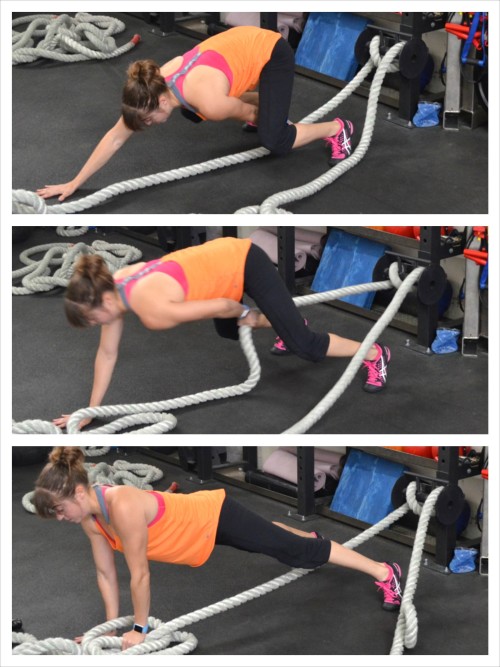
To do the Reverse Plank Pulls, set up in a plank position with your hands under your shoulders and your feet between hip-width and shoulder-width apart. You should be in this plank position with the rope between your legs.
Then, from this plank position, bend your knees and sit your butt back toward your heels as you reach one hand back through your legs to grab the rope.
Push off the balls of your feet and drive your hips forward to pull the rope up under your body and through toward your head.
As you pull the rope through, extend your hips and squeeze your glutes to help you power the pull. You don’t want to pull the rope through using only your arm. Do not let your hips sag though at the end. Keep your core engaged as you pull.
Sit back again and reach the other hand back and through to pull the rope. As you pull the rope through, make sure to extend your hips so that your hips help power the pull.
Keep alternating arms as you pull and make sure to use your legs and glutes to power the move.
These 10 Battle Ropes Pulls are a great way to work your entire core as well as your upper body. Use these Rope Pull Variations to target different muscles and work your core from every angle.
For more exercises using the Battle Ropes to build your strength and endurance, check out these 22 Battle Ropes Wave Exercises.

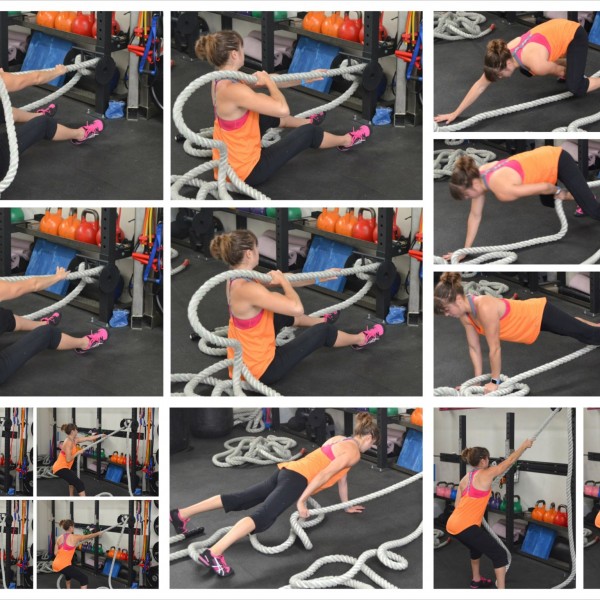
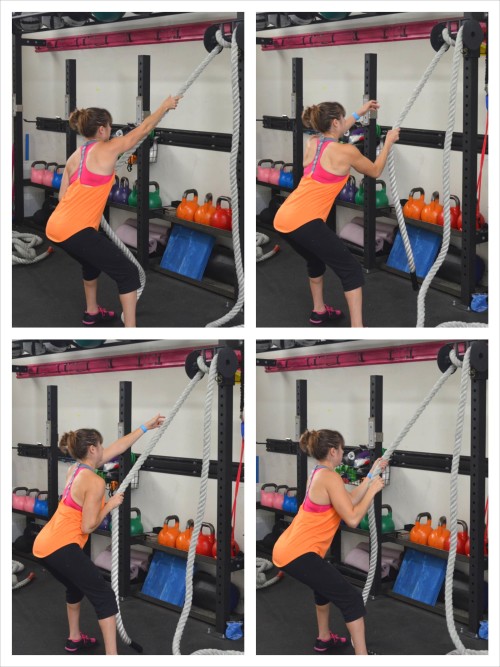


Very good article! Lots of info about exercise!
Thanks!
what is the name of the devise the rope is wrapped through to add the tension? Where would I be able to purchase one?
Hi Rick…so the anchor doesn’t create tension but it prevents it from moving? Not sure if that is what you are still looking for? It’s just a wall anchor. Here is what I have – http://goo.gl/E3K8tX 🙂
Super article! Looking for the same rope attachment you are using in the pics. It looks like it attaches to holes in squat racks which is genius! Unfortunately the link you provided to “Rick” in the above reply, is only for the traditional anchor…..the device in your pics is clearly something else – almost dumbbell shaped and made of heavy duty steel (?) maybe with some black powder coating? Is it a custom piece? Thanks!
Hi Laura. For the pulls it is custom made by Battlehouse Fitness 🙂
Hello Cori,
Very great post. I love the illustration of the workouts as well. Personally have never used a conditioning rope but I should do so soon.
Question, do you have a rope pull schedule or workout chart that could be useful for a newbie like me?
Andrew
I need to know how many calories are burned doing this exercise…… Where would or how would i find it?
Hi Karrie. You could perform it with a heart rate monitor on to see what you burn 🙂
Hi Andrew. I don’t. I’m so sorry! I do offer a Battle Ropes workout program but it is more waves than pulls. Honestly I love using these in my cardio workouts for like 1 minute intervals of work combined with towel taz and rower and such! 🙂